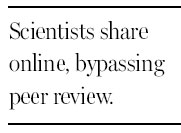Using the Web to open the scientific process
Updated: 2012-02-12 07:52
By Thomas Lin(The New York Times)
|
|||||||
For centuries, scientific research has been done in private, then submitted to journals to be reviewed by peers and published.
But to many scientists, the system seems hidebound, expensive and elitist. Peer review can take months, journal subscriptions can be prohibitively costly, and a handful of gatekeepers limit the flow of information.
It is an ideal system for sharing knowledge, said the quantum physicist Michael Nielsen, only "if you're stuck with 17th-century technology."
Dr. Nielsen and other advocates for "open science" say science can accomplish much more, much faster, in an environment of friction-free collaboration over the Internet. And, despite the skepticism of many scientists, their ideas are catching on.
Open-access archives and journals like arXiv and the Public Library of Science (PLoS) have sprung up in recent years. GalaxyZoo, a citizen-science site, has classified millions of objects in space, discovering characteristics that have led to a raft of scientific papers. And a social networking site called ResearchGate - where scientists can answer one another's questions, share papers and find collaborators - is rapidly gaining popularity.

Editors of traditional journals say open science sounds good, in theory. In practice, "the scientific community itself is quite conservative," said Maxine Clarke, executive editor of the commercial journal Nature, who added that the traditional published paper is still viewed as "a unit to award grants or assess jobs and tenure."
Dr. Nielsen, 38, who left a successful science career to write "Reinventing Discovery: The New Era of Networked Science," agreed that scientists have been "very inhibited and slow to adopt a lot of online tools." But he added that open science was coalescing into "a bit of a movement."
Science is moving to a collaborative model, "because it works better in the current ecosystem, in the Web-connected world," said Bora Zivkovic, a chronobiology blogger who is a founder of the annual ScienceOnline conference.
ResearchGate, the Berlin-based social network for scientists, is the brainchild of Ijad Madisch, 31, a Harvard University-trained virologist and computer scientist. "I want to make science more open," he said.
Started in 2008 with few features, it was reshaped with feedback from scientists. Its membership has mushroomed to more than 1.3 million, Dr. Madisch said, and it has attracted several million dollars in venture capital.
The Web site is a sort of mash-up of Facebook, Twitter and LinkedIn, with profile pages, comments, groups, job listings, and "like" and "follow" buttons, although only scientists are invited to pose and answer questions. It also offers a simple yet effective end run around restrictive journal access with its "self-archiving repository." Since most journals allow scientists to link to their submitted papers on their own Web sites, Dr. Madisch encourages his users to do so on their ResearchGate profiles.
Greg Phelan, chairman of the chemistry department at the State University of New York, Cortland, used the site to find new collaborators, get expert advice and read journal articles not available through his university.
Changing the status quo - opening data, papers, research ideas and partial solutions to anyone and everyone - is still far more idea than reality. As the established journals argue, they provide a critical service that does not come cheap.
"We have to cover the costs," said Alan Leshner, executive publisher of the nonprofit journal Science.
Those costs hover around $40 million a year, paying for more than 25 editors and writers, sales and production staff, and offices in North America, Europe and Asia, not to mention print and distribution expenses.
Peer-reviewed open-access journals, like Nature Communications and PLoS One, charge their authors publication fees - $5,000 and $1,350, respectively - to defray their more modest expenses.
Dr. Madisch acknowledged that he might never reach many of the established scientists for whom social networking can seem like a waste of time. But wait, he said, until younger scientists weaned on social media start running their own labs.
"If you said years ago, 'One day you will be on Facebook sharing all your photos and personal information with people,' they wouldn't believe you," he said. "We're just at the beginning. The change is coming."
Dr. Leshner agrees that things are moving. "Will the model of science magazines be the same 10 years from now? I highly doubt it," he said. "I believe in evolution."
The New York Times
(China Daily 02/12/2012 page12)